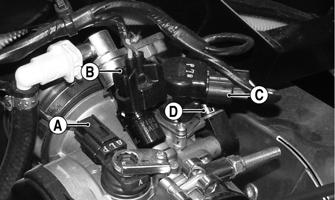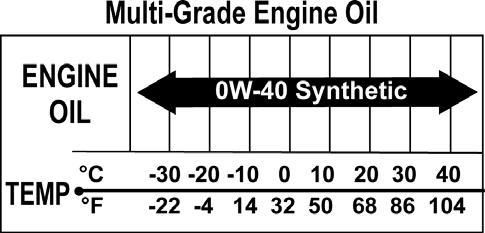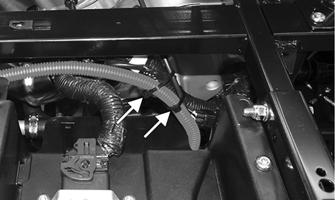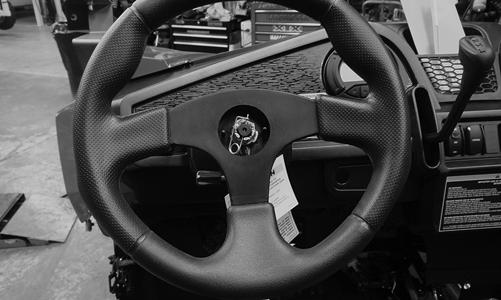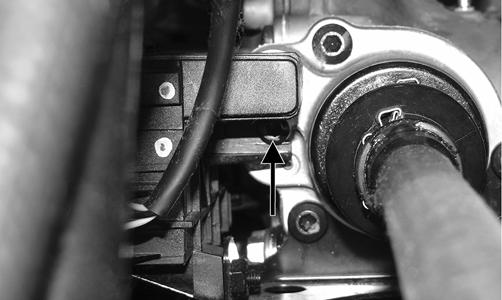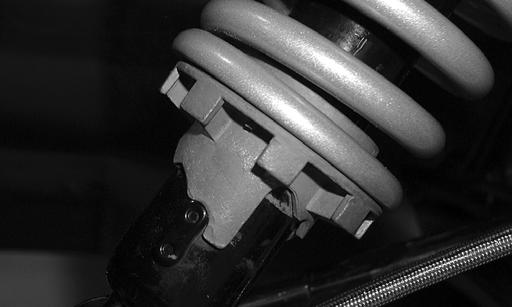
19 minute read
Periodic Maintenance/Tune-Up
Tighten all nuts, bolts, and cap screws. Care must be taken that all calibrated nuts, bolts, and cap screws are tightened to specifications. It is advisable to lubricate certain components periodically to ensure free movement. Apply light oil to the components using the following list as reference. A.Accelerator Pedal Pivot/Cable Ends B.Brake Pedal Pivot C.Shift Cable SPECIAL TOOLS A number of special tools must be available to the technician when performing service procedures in this section. Refer to the current Special Tools Catalog for the appropriate tool description. NOTE: When indicated for use, each special tool
will be identified by its specific name, as shown in the chart below, and capitalized.
Description p/n
Compression Tester Kit 0444-213 Oil Filter Wrench 0644-389 Timing Light 0644-296 Valve Clearance Adjuster 0444-255
NOTE: Special tools are available from the Arctic
Cat Service Department.
Air Inlet Pre-Filter
This vehicle is equipped with a foam pre-filter to filter dirt from the inlet air prior to reaching the main air filter. NOTE: To access the pre-filter, open the cargo box. 1.Gently squeeze the pre-filter cover and lift it up to expose the pre-filter.
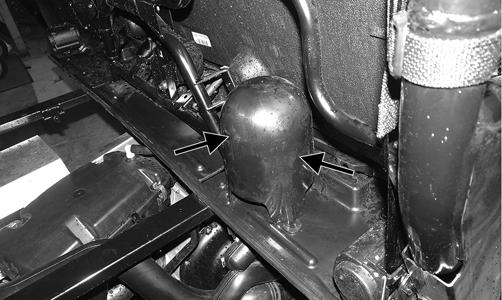
HDX237A
2.Loosen the clamp securing the pre-filter.
HDX235
3.Remove the pre-filter assembly and wash thoroughly in warm, soapy water; then rinse and dry. 4.Install and secure with the clamp. Tighten securely; then install the pre-filter cover.
Air Filter
CAUTION
Failure to inspect the air filter frequently if the vehicle is used in dusty, wet, or muddy conditions can damage the engine.
1.Remove any dust and debris from around the filter housing. 2.Unsnap the four spring-clip fasteners and remove the air filter cover.
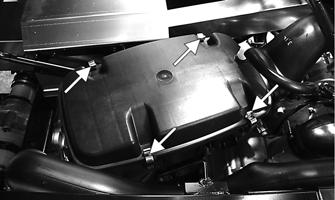
HDX050A
3.Remove the wing nuts securing the filter; then remove the filter. 4.Place the element in a pan larger than the element and spray all sides generously with cleaning solvent.
Let sit approximately three minutes. NOTE: Foam Filter Cleaner and Foam Filter Oil
are available from Arctic Cat.
5.In a pan larger than the element and with a mild detergent (dish soap) and water, wash all dirt and oil off by squeezing the element. Wringing or twisting the filter may cause damage. 6.Rinse off any remaining soap. Remove any excess water from the element by blotting with a towel. 7.Allow the element to dry completely.
9.Squeeze the element to remove excess oil. 10.Clean any dirt or debris from inside the filter housing. 11.Install the air filter and air filter screen. Secure with the wing nuts; then tighten securely and install the cover. CHECKING AND CLEANING DRAINS
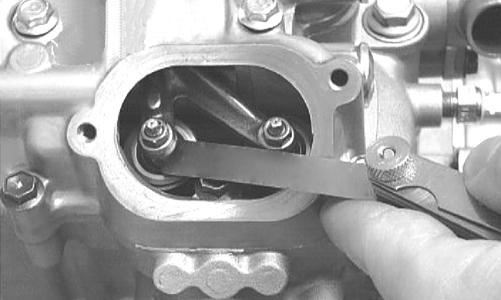
CAUTION
A torn air filter can cause damage to the vehicle engine. Dirt and dust may get inside the engine if the element is torn. Carefully examine the element for tears before and after cleaning it. Replace the element with a new one if it is torn.
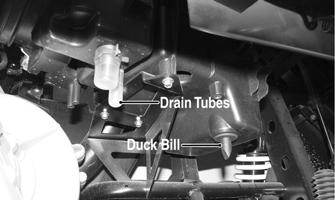
HDX283A
1.Inspect the “duck-bill” drain beneath the main housing for debris and for proper sealing. 2.Remove the drain tube and clean out any water, oil, or debris. Reinstall and secure with the clamp.
Valve/Tappet Clearance
NOTE: The engine must be cold for this procedure. NOTE: The seat, seat back, seat base, and spark
plug must be removed for this procedure.
1.Remove the spark plug and timing inspection plug; then remove the tappet covers (for more detailed information, see Engine/Transmission - Servicing
Top-Side Components). 2.Rotate the crankshaft to the TDC position on the compression stroke. NOTE: At this point, the rocker arms and adjuster
screws must not have pressure on them.
CHECKING Using a feeler gauge, check each valve/tappet clearance. If clearance is not within specifications, loosen the jam nut and rotate the tappet adjuster screw until the clearance is within specifications. Tighten each jam nut to 7 ft-lb after completing the adjustment.
CAUTION
The feeler gauge must be positioned at the same angle as the valve and valve adjuster for an accurate measurement of clearance. Failure to measure the valve clearance accurately could cause valve component damage.
VALVE/TAPPET CLEARANCE
Intake 0.1016 mm (0.004 in.) Exhaust (700) 0.1524 mm (0.006 in.) Exhaust (500) 0.17 mm (0.007 in.)
CC007D
ADJUSTING A.Place the Valve Clearance Adjuster onto the jam nut securing the tappet adjuster screw; then rotate the valve adjuster dial clockwise until the end is seated in the tappet adjuster screw. B.While holding the valve adjuster dial in place, use the valve adjuster handle and loosen the jam nut; then rotate the tappet adjuster screw clockwise until friction is felt. C.Align the valve adjuster handle with one of the marks on the valve adjuster dial. D.While holding the valve adjuster handle in place, rotate the valve adjuster dial counterclockwise until proper valve/tappet clearance is attained. NOTE: Refer to the specifications in CHECKING
for the proper valve/tappet clearance.
NOTE: Rotating the valve adjuster dial counter-
clockwise will open the valve/tappet clearance by 0.05 mm (0.002 in.) per mark.
E.While holding the adjuster dial at the proper clearance setting, tighten the jam nut securely with the valve adjuster handle. 3.Install the spark plug; then install the timing inspection plug. 4.Place the two tappet covers with O-rings into position. Tighten the cap screws to 8 ft-lb.
Testing Engine Compression
NOTE: The engine should be warm (operating tem-
perature) and the battery fully charged for an accurate compression test. The throttle must be in the wide-open throttle (WOT) position. In the event the engine cannot be run, cold values are included.
NOTE: The seat, seat back, and seat base must be
removed for this procedure.
1.Remove the high tension lead from the spark plug. 2.Using compressed air, blow any debris from around the spark plug. ! WARNING
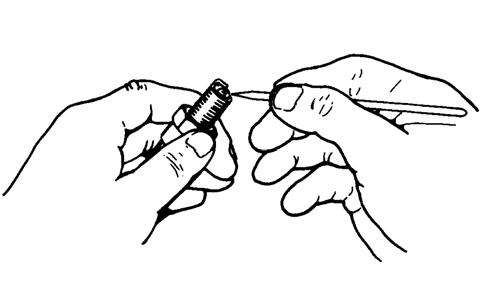
Always wear safety glasses when using compressed air.
3.Remove the spark plug; then attach the high tension lead to the plug and ground the plug on the cylinder head well away from the spark plug hole. 4.Attach the Compression Tester Kit. 5.While holding the throttle in the full-open position, crank the engine over with the electric starter until the gauge stops climbing (five to 10 compression strokes).
PSI Hot (WOT) PSI Cold (WOT)
125-145 (700) 100-140 (700) 213 (500) approx. N/A (500)
6.If compression is abnormally low, inspect the following items.
A.Starter cranks engine over. B.Gauge is functioning properly. C.Throttle in the full-open position. D.Valve/tappet clearance correct. E.Engine warmed up. F.Intake obstructed.
NOTE: To service top-side components, see Engine/
Transmission.
7.Pour approximately 30 ml (1 fl oz) of oil into the spark plug hole, reattach the gauge, and retest compression. 8.If compression is now evident, service the top end (see the appropriate Engine/Transmission - Top-Side
Components).
Spark Plug
A light brown insulator indicates that the plug and fuel/ air ratio are correct. A white or dark insulator indicates that the engine may need to be serviced. To maintain a hot, strong spark, keep the plug free of carbon.
ATV-0051
CAUTION
Before removing the spark plug, be sure to clean the area around the spark plug. Dirt could enter engine when removing or installing the spark plug.
On the 700, adjust the gap to 0.5-0.6 mm (0.019-0.024 in.). On the 500, adjust the gap to 0.7-0.8 mm (0.0280.031 in.).
ATV0052
A new spark plug should be tightened 1/2 turn once the washer contacts the cylinder head. A used spark plug should be tightened 1/8-1/4 turn once the washer contacts the cylinder head.
Muffler/Spark Arrester
Clean the spark arrester using the following procedure.
1.Remove the cap screws securing the spark arrester screen assembly to the muffler; then loosen and remove the spark arrester. Account for a gasket and wave washer. ! WARNING
Wait until the muffler cools to avoid burns.

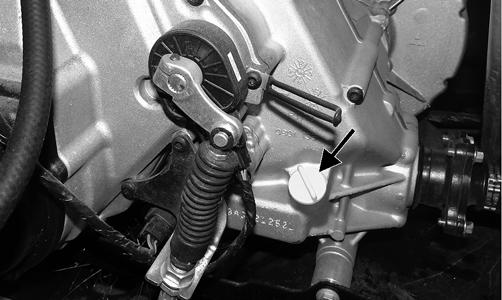
HDX284
2.Using a suitable brush, clean the carbon deposits from the screen taking care not to damage the screen. NOTE: If the screen or gasket is damaged in any
way, it must be replaced.
3.Install the spark arrester assembly with wave washer and gasket and secure with the cap screws. Tighten the cap screws to 50 in.-lb.
Engine/Transmission Oil - Filter
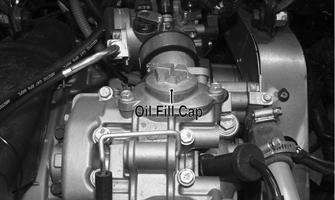
OIL - FILTER Change the engine oil and oil filter at the scheduled intervals. The engine should always be warm when the oil is changed so the oil will drain easily and completely. 1.Park the vehicle on level ground. 2.Remove the drain plug from the bottom of the engine and drain the oil into a drain pan; then remove the center console, seat, seat back, and seat base.
Account for and discard the drain plug gasket.
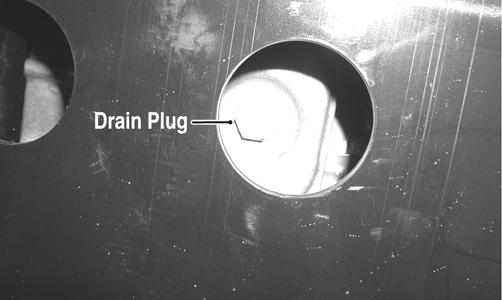
PR078A
3.Using the Oil Filter Wrench and a ratchet handle (or a socket or box-end wrench), remove the oil filter and discard the O-ring. NOTE: Clean up any excess oil after removing the
filter.
4.Apply fresh oil to a new filter O-ring and check to make sure it is positioned correctly; then install the new oil filter. Tighten securely. 5.Install the engine drain plug with a new gasket and tighten to 16 ft-lb. Pour the specified amount of the recommended oil in the filler hole.
500
HDX251B
700
HDX459A
CAUTION
Any oil used in place of the recommended oil could cause serious engine damage. Do not use oils which contain graphite or molybdenum additives. These oils can adversely affect clutch operation. Also, not recommended are racing, vegetable, non-detergent, and castor-based oils.
6.Start the engine (while the vehicle is outside on level ground) and allow it to idle for a few minutes. 7.Turn the engine off and wait approximately one minute; then unscrew the oil level stick and wipe it with a clean cloth. 8.Install the oil level stick and thread into the engine case. 9.Remove the oil level stick; the oil level must be within the operating range but not exceeding the upper mark.
GZ461A
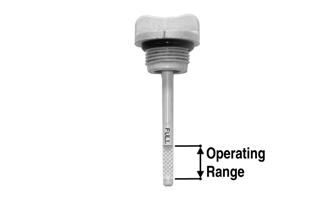
CAUTION
Do not over-fill the engine with oil. Always make sure that the oil level is not above the upper mark.
10.Inspect the area around the drain plug and oil filter for leaks.
Front Differential - Rear Drive Lubricant
To check lubricant, use the following procedure. 1.Remove the level plug (B); the lubricant should be level with the bottom threads.
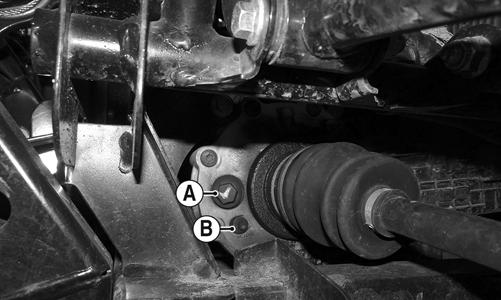
HDX221A
2.If low, remove the fill plug (A) and add the appropriate lubricant until it appears at the bottom of the level plug threads. To change the lubricant, use the following procedure. 1.Place the vehicle on level ground. 2.Remove each fill plug. 3.Drain the lubricant into a drain pan by removing in turn the drain plug from each.
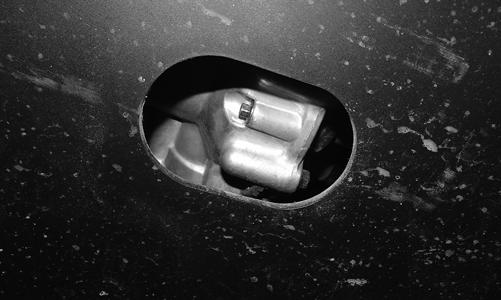
HDX255
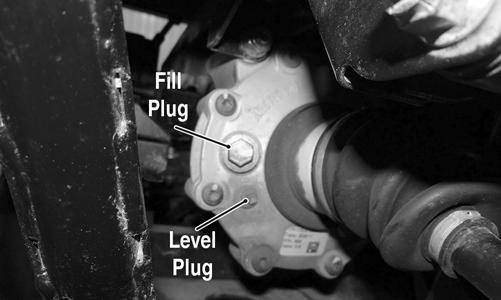
HDX220A
4.After all the lubricant has been drained, install the drain plugs and tighten to 45 in.-lb. 5.Pour the appropriate amount of recommended lubricant into the fill hole. 6.Install the fill plug and tighten to 16 ft-lb. NOTE: If the lubricant is contaminated with water,
inspect the drain plug, fill plug, and/or bladder.
Driveshaft/Coupling
The following drive system components should be inspected periodically to ensure proper operation. A.Spline lateral movement (slop). B.Coupling cracked, damaged, or worn. C.Universal joints worn or missing bearings.
Headlight - Taillight/ Brakelight
HEADLIGHT NOTE: The bulb portion of the headlight is fragile.
HANDLE WITH CARE. When replacing the headlight bulb, do not touch the glass portion of the bulb. If the glass is touched, it must be cleaned with a dry cloth before installing. Skin oil residue on the bulb will shorten the life of the bulb.
! WARNING
Do not attempt to remove the bulb when it is hot. Severe burns may result.
To replace the headlight bulb, use the following procedure. 1.Remove the wiring harness connector from the back of the headlight. 2.Grasp the bulb socket, turn it counterclockwise, and remove. Discard the bulb.
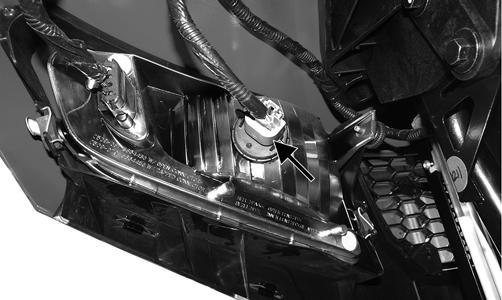
XR065C
3.Install the new bulb into the socket and rotate it completely clockwise in the housing. 4.Install the wiring harness connector. TAILLIGHT-BRAKELIGHT To replace the taillight-brakelight bulb, use the following procedure. 1.Remove the two cap screws and lock nuts and remove the light assembly. 2.Rotate the bulb socket counterclockwise to remove it from the light assembly; then pull straight out on the bulb. Push the new bulb straight into the socket. 3.Install the bulb and socket into the light assembly and turn clockwise to lock in place. 4.Install the taillight-brakelight assembly on the canopy support. CHECKING/ADJUSTING HEADLIGHT AIM The headlights can be adjusted vertically. The geometric center of the HIGH beam light zone is to be used for aiming. 1.Position the vehicle on a level floor so the headlights are approximately 6.1 m (20 ft) from an aiming surface (wall or similar aiming surface).
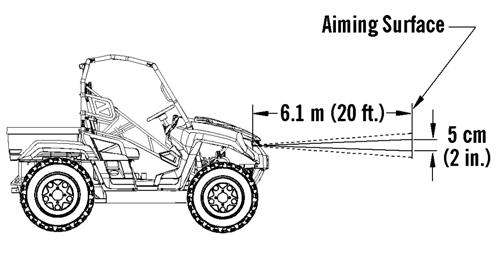
0748-733
NOTE: There should be an average operating load
on the vehicle when adjusting the headlight aim.
2.Measure the distance from the floor to the mid-point of each headlight. 3.Using the measurements obtained in step 2, make horizontal marks on the aiming surface. 4.Make vertical marks which intersect the horizontal marks on the aiming surface directly in front of the headlights. 5.Switch on the lights. Make sure the HIGH beam is on. DO NOT USE LOW BEAM. 6.Observe each headlight beam aim. Proper aim is when the most intense beam is centered on the vertical mark 5 cm (2 in.) below the horizontal mark on the aiming surface. 7.Loosen the headlight adjustment screw; then adjust the headlight up or down as required. Tighten the headlight adjustment screw.
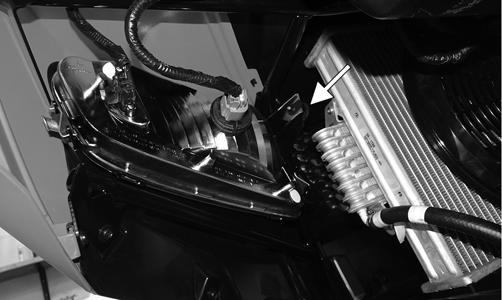
PR875A
Shift Cable
CHECKING SHIFT CABLE Turn the ignition switch on; then shift the transmission into park. The letter P should illuminate on the LCD gauge and the park icon (P) should illuminate. The vehicle should not be able to move.
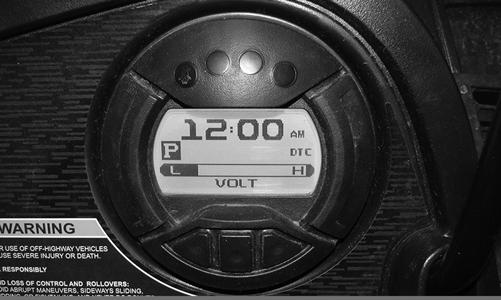
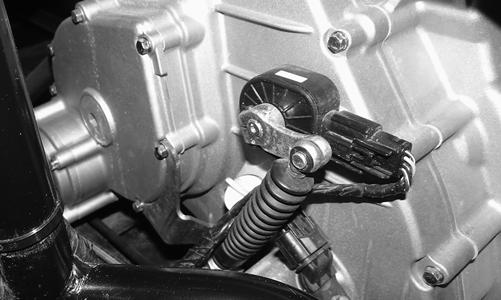
PR920
Move the shift lever all the way back. The letter L should illuminate on the LCD gauge.
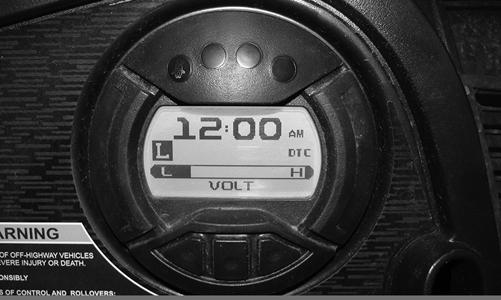
PR921
If either park or low range cannot be reached, the shift cable must be adjusted. ADJUSTING SHIFT CABLE 1.Place the transmission in park; then tilt the cargo box. 2.Make sure the shift lever is in park; then remove the
E-clip securing the cable end to the shift arm stud.
700
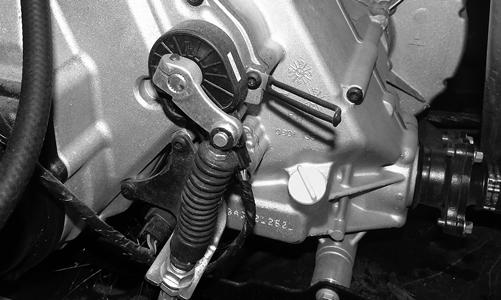
HDX251
500
HDX254
3.Loosen nuts (A) and (B) and adjust the cable housing to align the shift cable end to the shift arm stud.
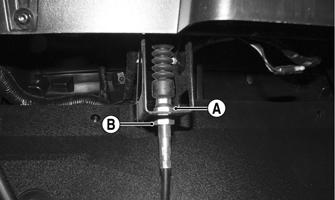
HDX261B
4.Install the E-clip; then tighten the nuts (A) and (B) to 8 ft-lb. 5.Check each gear shift position for proper gear selection and make sure the proper icon illuminates on the LCD.
Hydraulic Brake System
NOTE: This ROV is equipped with hydraulic
brakes at all four wheels.
CHECKING/BLEEDING The hydraulic brake system has been filled and bled at the factory. 1.With the master cylinder in a level position, check the fluid level in the reservoir. If the level in the reservoir is not above the MIN, add DOT 4 brake fluid.
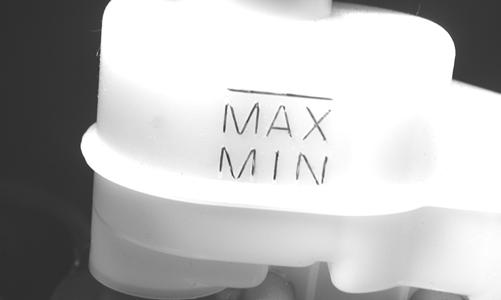
2.Depress the brake pedal several times to check for a firm brake. If the brake is not firm, the system must be bled. To bleed the brake system, use the following procedure. A.Remove the cover and fill the reservoir with DOT 4 brake fluid; then install and secure the cover. B.Slowly depress the brake pedal several times. C.Install one end of a clear hose onto the RIGHT
REAR bleeder screw and direct the other end into a container; then while holding slight pressure on the brake pedal, open the bleeder screw and watch for air bubbles. Close the bleeder screw before releasing the brake pedal. Repeat this procedure until no air bubbles are present.
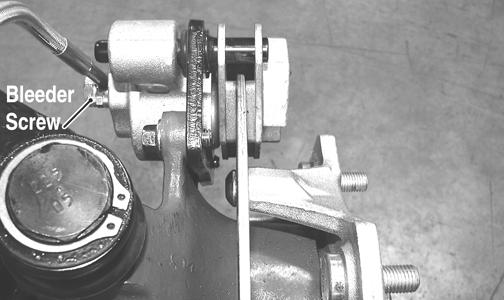
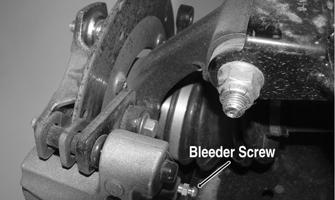
HDX285A
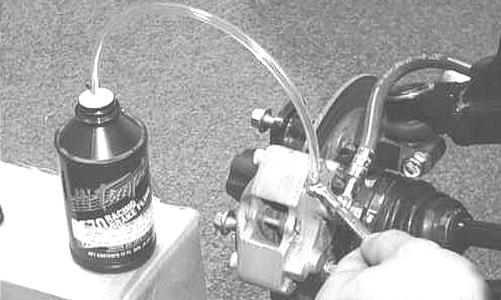
AF637D
NOTE: During the bleeding procedure, watch the
reservoir very closely to make sure there is always a sufficient amount of brake fluid. When the level falls below MIN, refill the reservoir before the bleeding procedure is continued. Failure to maintain a sufficient amount of fluid in the reservoir will result in air in the system.
D.At this point, perform steps B and C on the REAR
LEFT bleeder screw; then move to the FRONT
RIGHT bleeder screw and follow the same procedure. Finally, complete the procedure on the FRONT
LEFT bleeder screw.
PR377C
E.Repeat steps B and C until the brake pedal is firm. 3.Carefully check the entire hydraulic brake system to ensure all hose connections are tight, the bleed screws are tight, the protective caps are installed, and no leakage is present.
INSPECTING HOSES Carefully inspect the hydraulic brake hoses for cracks or other damage. If found, the brake hoses must be replaced. CHECKING/REPLACING PADS The clearance between the brake pads and brake discs is adjusted automatically as the brake pads wear. The only maintenance that is required is replacement of the brake pads when they show excessive wear. Check the thickness of each of the brake pads as follows. 1.Remove the wheel corresponding to the brake being checked. 2.Measure the thickness of each brake pad.
CAUTION
This hydraulic brake system is designed to use DOT 4 brake fluid only. If brake fluid must be added, care must be taken as brake fluid is very corrosive to painted surfaces.
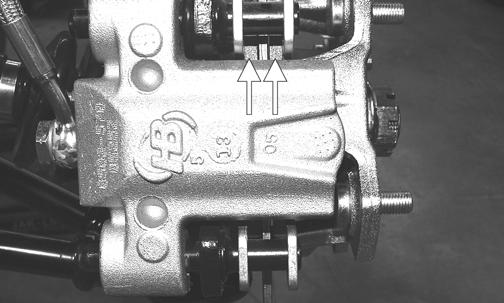
PR376A
3.If thickness of either brake pad friction material is less than 1.0 mm (0.039 in.), the brake pads must be replaced. NOTE: The brake pads should be replaced as a set. 4.To replace the brake pads, use the following procedure. A.Remove the cap screws securing the caliper holder to the knuckle; then remove the pads from the caliper.
PR237
B.Install the new brake pads. C.Secure the caliper holder to the knuckle with new
“patch-lock” cap screws. Tighten to 20 ft-lb.
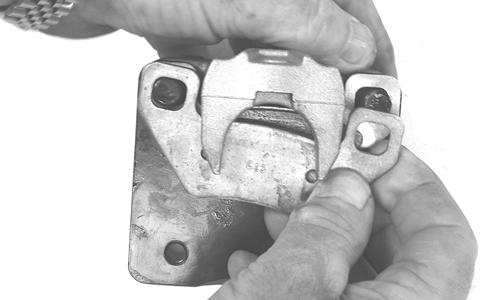
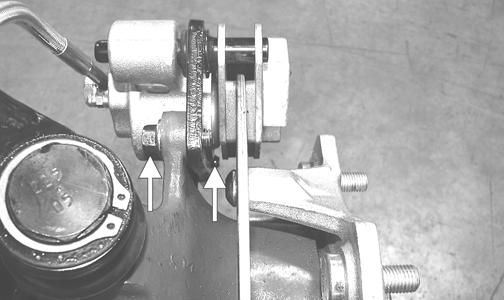
PR377B
5. Install the wheels and using a crisscross pattern, tighten the wheel nuts in 20 ft-lb increments to a final torque of 40 ft-lb (steel wheel), 60 ft-lb (aluminum wheel w/black nuts), or 80 ft-lb (aluminum wheel w/ chrome nuts). 6.Burnish the brake pads. BRAKE DISC Using a micrometer, measure the thickness of the brake disc in the contact surface. If thickness is 0.125 in. or less, the disc must be replaced. To replace the brake disc, see Drive System – Hub.
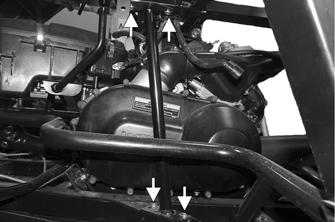
Burnishing Brake Pads
Brake pads must be burnished to achieve full braking effectiveness. Braking distance will be extended until brake pads are properly burnished. ! WARNING
Failure to properly burnish the brake pads could lead to premature brake pad wear or brake loss. Brake loss can result in severe injury or death.
1.Choose an area large enough to safely accelerate the vehicle to 30 mph and to brake to a stop. 2.Accelerate to 30 mph; then release the accelerator pedal and depress the brake pedal to decelerate to 0-5 mph. 3.Repeat procedure 20 times until brake pads are burnished.
Checking/Replacing V-Belt
REMOVING 1.Remove the seat, seat back, and seat base; then remove the floor and gas tank. 2.Remove the right-side storage box. 3.Remove the cap screw, lock nut, and clamp securing the intake duct and duct tube assembly. Then remove the assembly.
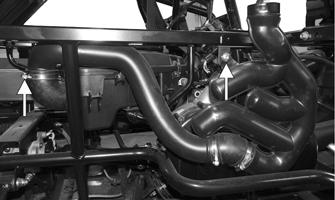
HDX258A
4.Remove the cap screws securing the support tube to the frame.
HDX260A
5.Remove the cap screws securing the CVT cover noting the location of the different-lengthed cap screws for installing purposes; then using a rubber mallet, gently tap on the cover tabs to loosen the cover.
Remove the cover.
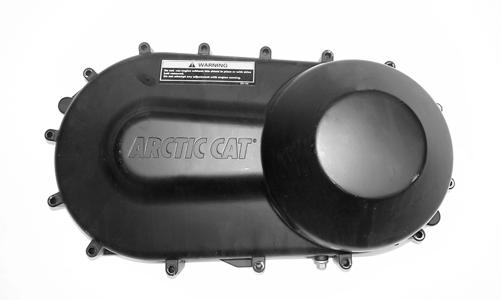
6.Remove the nut securing the movable drive face; then remove the face. Account for the spacer. NOTE: Keep the drive face plate in contact with the
drive face when removing or installing the drive face to prevent the rollers from falling out.
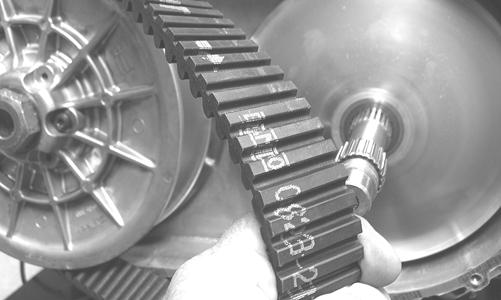
CF364A
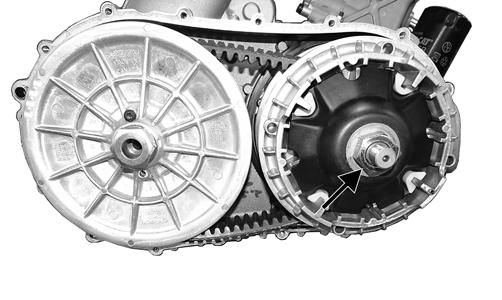
CD966A
7.Install one of the CVT cover cap screws into the driven pulley fixed face; then turn the cap screw clockwise to spread the pulley faces. Remove the Vbelt.
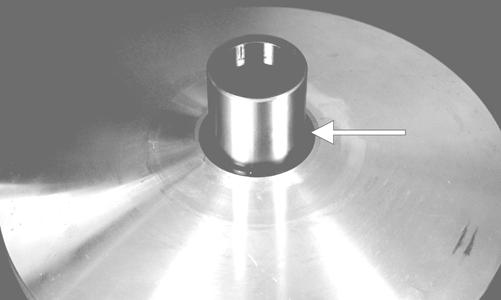
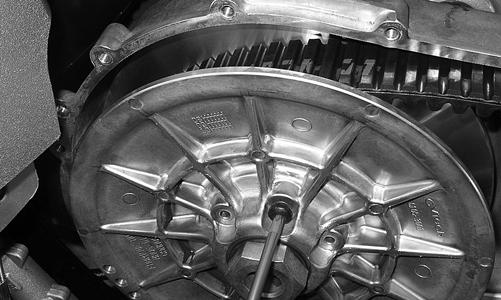
GZ076 GZ085
CHECKING Use Drive Belt Gauge to identify any abnormal wear. Measure across the top of the V-belt (in multiple locations) using a Vernier caliper. Do not squeeze the belt as doing so may produce an inaccurate measurement. The V-belt must be at least 28.5 mm (500) or 35.0 mm (700) at any point. INSTALLING 1.Place the V-belt into position on the driven pulley and over the front shaft.
GZ085
NOTE: The arrows on the V-belt should point in
direction of engine rotation (forward).
2.Pinch the V-belt together near its center and slide the spacer and movable drive face onto the front shaft.
Secure the drive face with a new nut (on the 700, threads coated with red Loctite #271). Using an appropriate spanner wrench, tighten the nut to 147 ftlb (500) or 162 ft-lb (700).

CF366
Make sure the movable drive face plate is fully engaged onto the splines of the clutch shaft before tightening the nut or false torque readings may occur. This will cause the assembly to loosen damaging the shaft and clutch face plate.
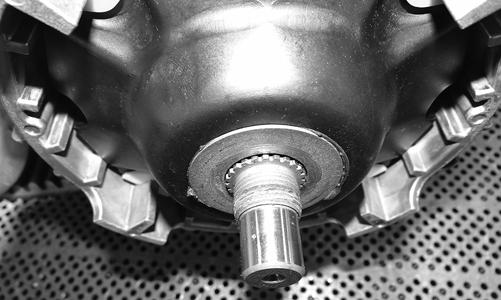
CF379
NOTE: At this point, the CVT cover cap screw can
be removed.
3.With the vehicle in neutral, rotate the V-belt and clutches counterclockwise until the V-belt is flush with the top of the driven pulley. 4.Place the CVT cover gasket into position; then install the cover and secure with the cap screws making sure the different-lengthed cap screws are in their proper location. On the 700, tighten the cap screws with washers to 44 in.-lb. On the 500, tighten the cap screws to 8 ft-lb.

H1-017
5.Install the support tube to the frame; then position the intake duct and tube in place. Secure with the cap screw, lock nut, and clamp. 6.Install the right side storage box. 7.Install the gas tank and floor; then install the seat back, seat base, and seat.

